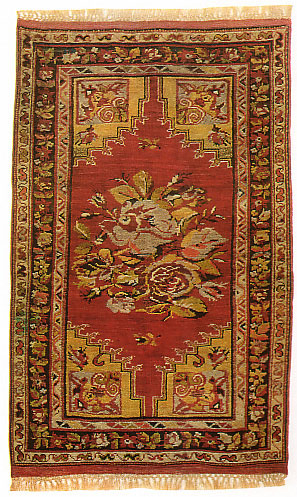This little rug has been presented to me as a Karabagh "saddle" rug. I think this is a vagireh, but I am not sure of the origin.
I have not any datas on the structure of this floral rug.

Amitiés à tous
Louis
vagireh for identification
Bonjour à tous
This little rug has been presented to me as a Karabagh "saddle" rug. I think
this is a vagireh, but I am not sure of the origin.
I have not any datas on the structure of this floral rug.

Amitiés à tous
Louis
Louis -
It could well be Caucasian.
There are lots of Caucasian rugs that show European design influences and a
particular group that exhibit roses/carnation. See Bennett, pp. 292-294.
The "story" usually is that they were ordered (at least originally) by Russian
officers stationed in the Caucasuses.
The Russian elites had a clear admiration for things western from Peter the
Great onward. I think French was the frequently the language of upper class
parlance. When Bogolyubov published his famous book on Turkmen weavings he did
so in French.
I would call this a wagireh too especially because of the drawing of its lower
half.
Regards,
R. John Howe
Hi Louis,
It looks to me that it is a Central Anatolian rug has been Woven in Maden/Nigde
area.
Regards.
Cevat Kanig
Hi Cevat -
Indicators?
Regards,
R. John Howe
John,
The rug shows a niche format (upside down in the photo), steeply stepped, which
is frequent in Maden/Camardi/Nigde rugs, especially their prayer rugs. The brown
of the niche is also characteristic. This piece may show that the previously
pre-commercial production was being oriented towards contemporaneous tastes
in order to generate market share. Just as the Karabagh rugs went from geometric
to floral for the Russian market.
Patrick Weiler
Hi Pat -
Thanks for these indicators.
What is you source? Can you recommend a good book on Turkish pile weaving?
Most of what I see are specialty volumes, but I don't know of a good general
book on Turkish pile pieces (that is for less than $600).
Regards,
R. John Howe
Hi John,
Next time, i will try to remember Indicators.
Regards.
Cevat Kanig
Book
John,
I have only found one book that showed rugs from this region. It was in a college
library that I visited over 10 years ago. It was a large book and had a very
wide range of Turkish pile rugs. I believe it may be this book:
Iten-Maritz TURKISH CARPETS 1977. The world of Anatolian carpets explored and
illustrated, from folk art rugs to the looms of the sultans. History, ethnography,
social, religious aspects; the main portion contains detailed descriptions of
rugs according to the area of production. Hardbound with jacket. 9.75 x 10.25.
357 pages. 180 color illustrations. 10 maps.
I copied this description from The East-West Room web site.
Subsequent to the publishing of this book, the whole cult kilim thing and interest
in very old Anatolian flatweaves began and eclipsed any interest in "boring,
plain old Turkish rugs". So there has not been much published about them since
then.
Patrick Weiler
Thanks, Pat -
There were about 20 copies of this book yesterday on ABE. About $60 at the low
end. I ordered one.
I had never heard of it, but it's listed in O'Bannon's bibliography where he
describes it briefly and rather non-commitally as:
"A comprehensively illustrated general work on these rugs."
We'll see when it arrives.
The book that is generally recommended on Turkish pile weaving is Bruggeman
and Bohmer's "Rugs of the Peasants and Nomads of Anatolia," 1983, which O'Bannon
says is "excellent; TechAnal." My understanding is that it currently sells for
nearly $600. Too rich for my blood. 
Thanks, again,
R. John Howe
Hi John and all,
Iten-Maritz published some good reference books, Turkish Carpets among them.
On page 211 there is a rug that seems to correspond with Louis’ wagireh:

He identifies this as a Fethiye from around 1920 and says of the group: “…before
being renamed Fethiye in 1923, the town was called Megri, and carpets of that
name were greatly renowned.”
Megri rug are perhaps most commonly called Makri in the rug trade and differ
markedly from this example. The old ones generally have two panels in the field
and strong and attractive colors. This group, like many others in Turkey, suffered
aesthetically from the introduction of synthetic dyes. It is hard for me to
think of any category of rugs with such repulsive colors as those produced in
Turkey during most of the 20th Century. I had not realized the fate of Makri
or Megri weaving.
Wendel